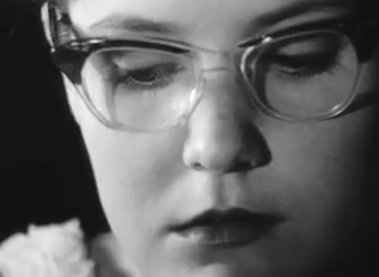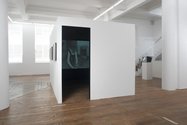John Hurrell – 29 January, 2016
Most of these works have a raw, casual aesthetic that avoids slickness or prettiness, often drawing on traces from the mechanical processes of developing film to revel in image or motivational ambiguity, and blocking conventional (patriarchal) narrative interpretation. This is further enhanced by strategies such as the use of grainy prints, low illumination, inserted sections of other photographs, scratched-over writing, discontinuity, distortion, and erasure - coupled with reoccurring themes such as domestic claustrophobia, ‘wifely' manual labour, and ‘hysteria.'
Auckland
Janet Bayly, Minerva Betts, Popular Productions, Rhondda Bosworth, Jane Campion, Alexis Hunter, Joanna Margaret Paul
Fragments of a World
Curated by Dr. Sandy Callister
20 January - 20 February 2016
The title of this exhibition of photographs and film, recently presented at the Adam at Victoria University, comes from a book published in 1976 which looked at the work of 31 women artists. Here then are seven of them - selected well known contributors - forty years down the line, as part of a current burgeoning interest in late seventies /early eighties feminism and the various technologies that emerged at that time such as Polaroid, film and (tangentially) video.
Most of these works have a raw, casual aesthetic that avoids slickness or prettiness, often drawing on traces from the mechanical processes of developing film to revel in image or motivational ambiguity, and blocking conventional (perceived as ‘patriarchal’) narrative interpretation. This is enhanced by strategies such as the use of grainy prints, low illumination, inserted sections of other photographs, scratched-over writing, discontinuity, distortion, and erasure - coupled with reoccurring themes such as domestic claustrophobia, ‘wifely’ manual labour, and ‘hysteria.’ These seven very individual artists seem surprisingly cohesive, especially in the Lett space which is much more compact than the more elongated Adam.
The combined contributions - with their anti-narrative and ‘anti-expressive’ expressiveness - lock in and overlap nicely. The biggest surprise here is Jane Campion’s student film, A Girl’s Own Story, made at the Australian Film, Television and Radio School in Sydney in 1984. Set in the mid sixties and exploring themes like teenage pregnancy, pubescent sexual awakening, adult hypocrisy and marital breakdown, its brilliant cast and direction makes it look surprisingly refreshing today. Subtle in what it doesn’t state but only suggest (you joining the dots), this short b/w film (click here to see) uses great editing and performances of songs at the beginning and end to emotionally intensify its dysfunctional family content.
Joanna Margaret Paul’s 1982 short film, Task, examines the monotony of a wife ironing and folding her husband’s trousers, while her photographs (from 1976) of the darkened interior of a house suggest depression and bleak boredom in comparison to the sunlit landscape glimpsed through the windows. It is about interiors, subjugation and interiority together.
Alexis Hunter‘s photo sequences elaborate on two forms of violence. One violently anti-violent sequence shows a blood splattered wall (as if evidence of a crime - perhaps against a woman) being systematically demolished (with greater ferocity) with an axe, leaving a large gaping hole, with rubble below. The other photo sequence shows Hunter mutilating a pair of strap-on pumps with a blade, after she has removed them from her blistered bleeding feet.
Janet Bayly‘s blurred self portraits in a mirror and cropped shots of a red summer dress drying on the line, emphasise a dematerialisation of the (often moving) female body, a flimsy ephemerality and corporeal distortion gained from the rapid processing and graininess of the Polaroid, that is enhanced when enlarged. As meditations on the Self they resist clear definition. In another suite of self portraits with torso, Bayly’s hair hangs over her face so that the repeated positioning (from a distance) become ambiguous: is she facing the camera or with her back to it? She subverts expectations associated with the subject’s frontal gaze, and mocks the fetishisation of hair.
The photographs of Rhondda Bosworth look at subject matter often considered until then unphotographable, such as scraps of paper bearing handwriting, black oblongs of photographic negatives and cut out bits of earlier photographs. Sometimes the room in which she poses is swelling as if it is about to burst, or she is contorting her moving body in strange positions as if at the mercy of powerful forces far beyond the domain of the constructed gendered self.
Minerva Betts‘ low card table presents an array of photographs partially covered by scribbled text or smeared oil pastel. Images of lamps chairs, pots, wall sections, carpet and lino provide shuffled around backdrops of exuberantly thwarted interpretation. Her framed photograph on the windowed wall nearby shows a desk presenting a curling piece of collage, an enigmatic cross between birthday cake, typewriter and naval cap, a work that defies meaning and embraces unruly sensation and subjectivity instead.
This is a fascinating show because its pre-digital aesthetic (such as the opening and closing credits for Popular Productions’ The Story Of) [click here to see] now seems somewhat at odds with current trends of high production finish. Although its promotion talks about these works as precursors of contemporary technology it is actually intriguing for other reasons. In the context of when these works were made, Arte Povera (‘poor’ or ‘impoverished’ art) seems like an influence (in materiality and style, not content), and that the artists here can also be seen in terms of a much wider group of (extremely varied) feminist art practices that includes Christine Hellyar, Di Ffrench, Juliet Batten and Vivian Lynn. With its dislike for slickness and smooth finish as part of a deep suspicion of representation, the exhibition has a strong sense of conceptual gesture or sustained mental impulse. An extremely interesting, vibrant and punchy presentation.
John Hurrell





















 Advertising in this column
Advertising in this column Two Rooms presents a program of residencies and projects
Two Rooms presents a program of residencies and projects



This Discussion has 0 comments.
Comment
Participate
Register to Participate.
Sign in
Sign in to an existing account.